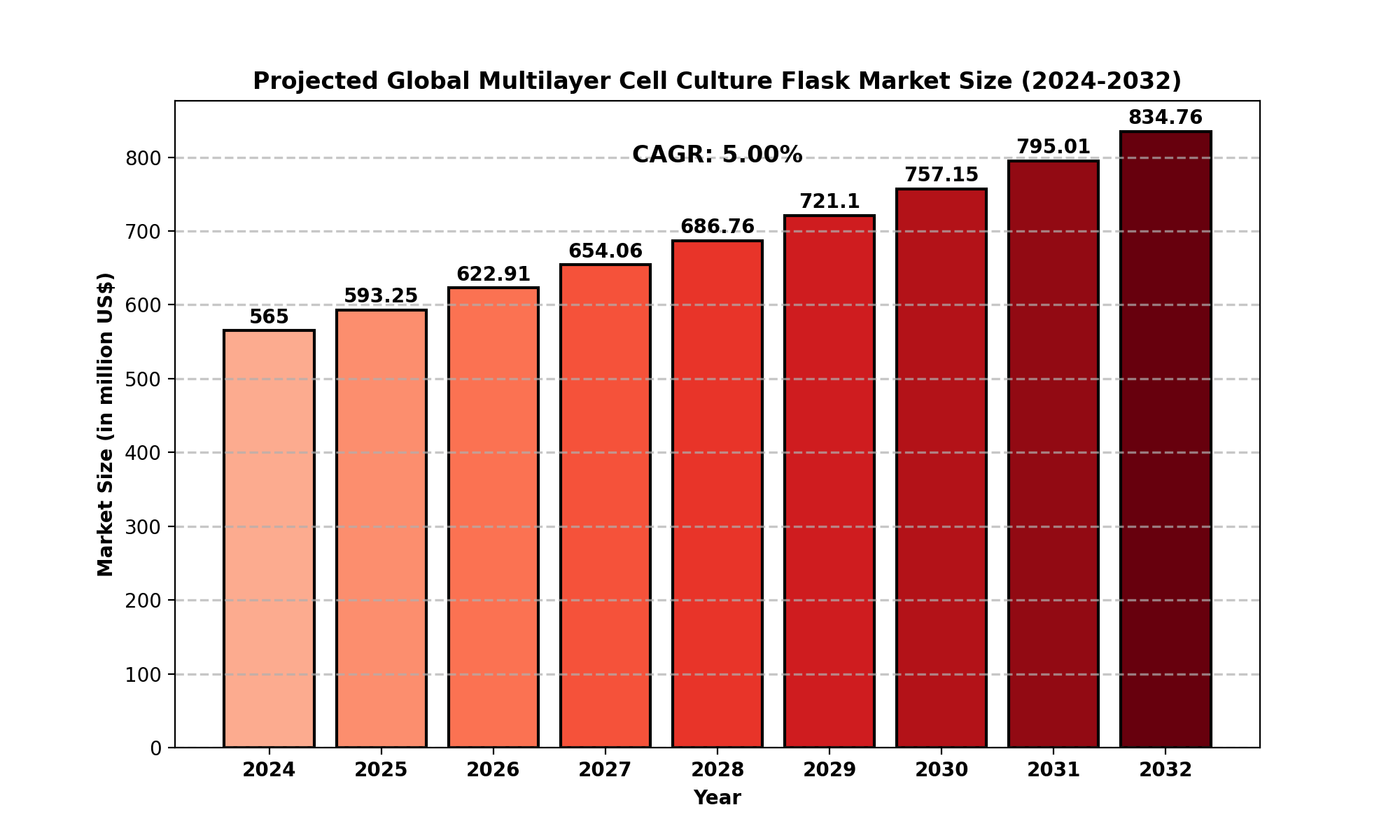TOP CATEGORY: Chemicals & Materials | Life Sciences | Banking & Finance | ICT Media
Multilayer cell culture flasks are advanced laboratory tools designed to maximize cell growth while minimizing the space required for culture expansion. These flasks facilitate the low-cost expansion of cell cultures and provide a surface optimized for the adhesion and growth of adherent cells. The design ensures efficient nutrient exchange and gas permeability, making them ideal for large-scale cell culture applications in laboratories and pharmaceutical research.
The global multilayer cell culture flask market was valued at USD 565 million in 2024 and is projected to reach USD 834.76 million by 2032, exhibiting a CAGR of 5.00% during the forecast period.
North America’s market size was estimated at USD 160.11 million in 2024, with a CAGR of 4.29% from 2025 to 2032.
Market expansion is driven by increasing investments in biopharmaceutical research and advancements in cell culture technologies.
The demand for multilayer cell culture flasks is rising due to their efficiency in large-scale cell culture production and their applications in drug development and disease research.

Drivers
Growing Biopharmaceutical Industry: The rising prevalence of chronic diseases has led to increased investments in biopharmaceutical R&D, driving demand for cell culture technologies.
Advancements in Cell Culture Technology: Innovations in surface modification and cell adhesion techniques have improved the efficiency of multilayer flasks.
Rising Demand for Personalized Medicine: The need for customized cell-based therapies has propelled the demand for advanced cell culture tools.
Increased Government and Private Funding: Supportive policies and funding for life sciences research encourage the adoption of cell culture solutions.
Restraints
High Cost of Advanced Cell Culture Equipment: Initial setup and operational costs can be prohibitive for small research labs.
Stringent Regulatory Requirements: Compliance with biopharmaceutical manufacturing standards and regulatory approvals can slow down market adoption.
Limitations in Scalability: Some multilayer flasks have limitations in large-scale production, necessitating alternative culture methods.
Opportunities
Emerging Markets in Asia-Pacific: Countries like China and India are investing in biotechnology research, providing growth opportunities.
Integration of Automation in Cell Culture: Automated systems for cell monitoring and media exchange can enhance efficiency and scalability.
Expansion of Cell-Based Therapies: Increasing applications in stem cell research and regenerative medicine create new market opportunities.
Challenges
Standardization Issues: Variability in flask materials and coatings can affect reproducibility in research outcomes.
Competition from Alternative Culture Methods: 3D cell culture and bioreactors may pose a challenge to traditional multilayer flasks.
North America
Dominates the market due to strong biopharmaceutical infrastructure and research funding.
Key players such as Thermo Fisher Scientific and Corning drive market growth.
Europe
Strong presence of pharmaceutical industries in Germany, the UK, and France.
Regulatory support for cell-based research fuels demand.
Asia-Pacific
Rapid growth in biotechnology sectors in China, Japan, and India.
Increasing government initiatives to support life sciences research.
South America
Expanding biopharmaceutical investments in Brazil and Argentina.
Growth potential in research institutions and universities.
Middle East and Africa
Emerging markets with increasing focus on healthcare and medical research.
Investments in biotechnology infrastructure to boost market growth.
Major companies operating in the multilayer cell culture flask market include:
Corning
Thermo Fisher Scientific
Nest Scientific USA
Greiner Bio-One
Guangzhou Jet Bio-Filtration
Merck KGaA
Luoyang Fudau Biotechnology
FeiFanT
These companies focus on product innovation, strategic collaborations, and geographical expansion to strengthen their market presence.
Three Floors: Preferred for small-scale cell culture applications.
Five Floors: Used in large-scale research and biopharmaceutical manufacturing.
Other: Customizable configurations based on research needs.
Laboratory: Academic and clinical research applications.
Pharmaceutical: Drug development and cell therapy research.
Other: Biotechnology companies and industrial research facilities.
North America (USA, Canada, Mexico)
Europe (Germany, UK, France, Russia, Italy, Rest of Europe)
Asia-Pacific (China, Japan, South Korea, India, Southeast Asia, Rest of Asia-Pacific)
South America (Brazil, Argentina, Colombia, Rest of South America)
Middle East and Africa (Saudi Arabia, UAE, Egypt, Nigeria, South Africa, Rest of MEA)
What is the current market size of the Multilayer Cell Culture Flask market?
Which are the key companies operating in the Multilayer Cell Culture Flask market?
What are the key growth drivers in the Multilayer Cell Culture Flask market?
Which regions dominate the Multilayer Cell Culture Flask market?
What are the emerging trends in the Multilayer Cell Culture Flask market?